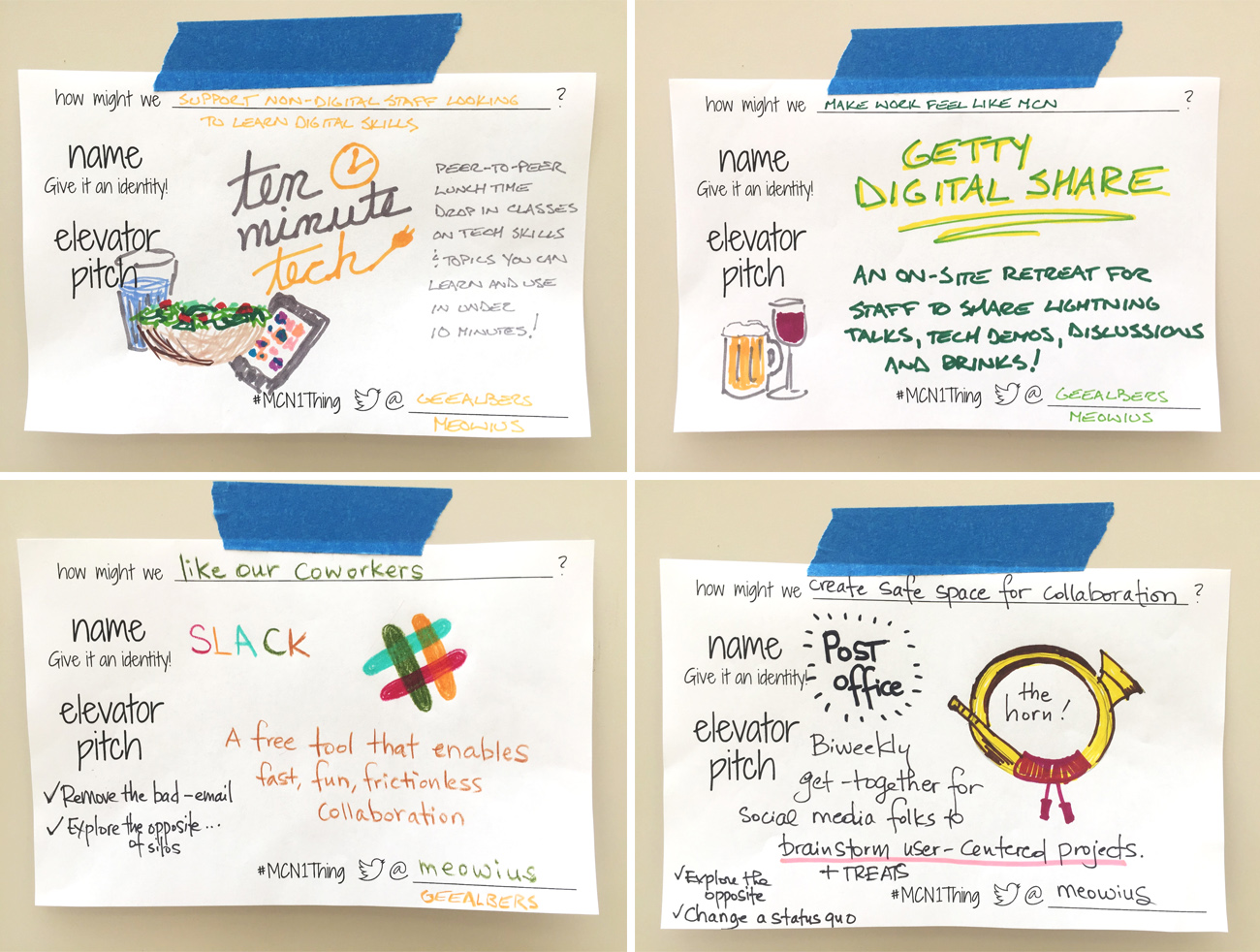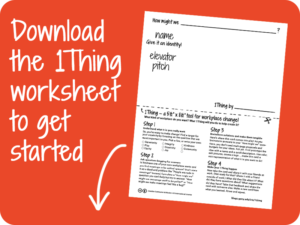The two of us work on digital publications and digital engagement respectively here at the Getty, but in between building books and running social media projects we often find ourselves hatching plans to increase digital literacy and joyful culture across the institution. Over the last couple years we’ve run a series of 10-minute peer-to-peer technology classes, gone semi-rogue introducing new communications tools and meeting formats, and co-hosted a 100-person on-site retreat for staff working on digital projects, among other things. The premise of these side projects has always been that individuals like us, at any spot in the org chart (we’re each sort of in the middle of ours) can and should strive to make meaningful cultural change where and when they can.
Aside from making for a better workplace for us individually, we believe this kind of grassroots effort can have a cumulative and lasting positive impact across an organization over the long term. The effect may be magnified as more staff are motivated to participate similarly, though we’ve struggled with this here at the Getty.
We started with the idea that if we created some of the interactions we wished existed, at least a few of our peers would be inspired to join us and come forward with their own ideas. We’ve also hosted meetups where our colleagues have come up with all sorts of amazing ideas for demos, workshops, trainings, lunch circles, and other skill-building, knowledge-sharing schemes. Together we’re on the right track, but so far only a few of these great ideas have materialized. We’ve been thinking a lot about why this is, and what gives an idea momentum.
For a session at the most recent MCN (Museum Computer Network) conference (held November 1–4, 2016, in New Orleans; the theme was The Human-Centered Museum), we wanted to mirror the culture-changing side projects we’ve been doing, but we also took the opportunity to tackle this empowerment/agency problem for ourselves—and for session attendees. We started by honing in on our process. What is at the core of what we’re doing here, and how could we codify that in as minimal a way possible? Through this, we’ve realized that all our efforts, no matter how big or small, have always started with two very simple questions:
- What kind of workplace do we want?
- What one thing will we do to help create it?
Step 1: Understand what it is you really want
We’ve found it helpful to take a moment to think about what it is we want out of work, and this goes deeper than things like better pay or a better boss. (Our bosses are great. We’re talking hypotheticals here.)
Instead, we try to consider the root emotional and social qualities that are most important to us, and how it would look if these qualities were present. So, you might think not (or not only) better pay but acknowledgment of your hard work. Not a better boss but support to keep growing in your job. Your guiding values or ideals. Here are some of ours:
Annelisa: Generosity, Integrity, Kindness, Play
Greg: Creativity, Community, Equity, Joy
The idea here is: a) it’s healthy to have a better sense of your own needs and how they may be affecting your work culture/experience for better or worse, b) you can create immediate positive change to fulfill those needs, and c) if you want something, chances are that at least some of your colleagues do as well. So if you can address your needs, you’ll also be addressing some of theirs.
Step 2: Formulate those wants into questions begging for answers
Over the last two or three years, staff around the Getty have increasingly been using design-thinking methodologies to tackle new projects. We cherry-picked a couple of those techniques for this process. One was using “How might we…” questions. By framing challenges as questions starting with “How might we…,” you lead yourself to start thinking of solutions.
For example, let’s say you’ve identified kindness as one of your core workplace wants, and you know that certain meetings tend to be contentious, unkind spaces. If you say, “the problem is that people are rude to one another in meetings,” it’s a mental dead end. The answer to that statement, if you bother to answer it at all, is “Yes, that’s a problem.” If, however, you reframe that problem as a “How might we…” question, you suggest that a solution is possible and give yourself an opening for brainstorming one:
“How might we encourage staff to be polite in meetings?”
Or, better yet, really own the kindness aspect you’re after:
“How might we make meetings feel like a hug?”
Step 3: Brainstorm solutions and make them tangible
When you start brainstorming answers to your “How might we…” questions, don’t feel like you have to find the perfect idea right away, or that it has to be the most all-encompassing be-all and end-all solution to the problem. The goal is to find a single, achievable idea that you can use to address the issue and bring a bit of positive change to your workplace. This is what we call our “one thing”. When you come up with your most promising “one thing” the next step to test and refine it. For that, we can turn to another key component of the design-thinking process, prototyping.
Creating a prototype, or mock-up, of your solution gives you something you can put in front of real users to get their feedback. The simpler and quicker-to-make your mock-up is (they’re often made with paper and markers), the less you have to lose if your testers find some problem with it and the easier it is to iterate on your idea and try again. The goal is to do just enough to communicate the key parts of the project or idea you want to test. But what are the key parts of these culture-changing projects we’re trying to get off the ground?
Looking back and evaluating some of the past projects we’ve been part of, we realized they had two very simple common traits. The staff retreat was called the Getty Digital Share—not “conference” or “summit”—and Getty folks responded as if “digital shares” were a thing people did elsewhere, like unconferences or meetups. This helped us all feel excited to participate. The digital-skill-building program, led by a team of volunteer teachers, was described as peer-to-peer drop-in classes and called 10-Minute Tech. It even had its own logo, which staff UX designer Cathy Bell did for us! In our experience, successful ideas had a catchy name and a brief description that struck a chord and were short enough for people remember and pass on.
At its most basic, then, a successful idea prototype has only two things:
- Name or identity
- Elevator pitch

For the prototype itself, we think it’s important to have something tangible, so we created some simple cards for MCN, and brought a pile of colorful markers, asked participants to think of names and an elevator pitch for their idea, and then asked them to write or draw it. The card made it physically tangible, the name gave it an identity, and the elevator pitch gave them a way to test it by pitching it to potential collaborators. This is the minimum viable product, or as Allegra Burnette (of Forrester Research and formerly MoMA) put it in another MCN session, the minimum loveable product.

As a side note, the “How might we…” + “one thing” model is also helpful to improve existing processes or projects—it doesn’t have to be the beginning of a big new initiative. Making a recurring meeting more productive, or changing the tone of an email chain, can have a big emotional impact. For example, a monthly info-sharing meeting of social media folks became a biweekly collaborative brainstorm known as POST Office, got an emoji (the horn), and has been re-energized with a new process. (Thanks to our Getty Publications colleague Miranda Sklaroff, founding POST Office captain and bringer of treats!)
Step 4: Make your “one thing” happen

Download the 1Thing worksheet
The cards and the process are a way to distill positive change into manageable, vision-able bits. You don’t need a massive institutional effort. You don’t need to accomplish everything at once. Just find one thing you can do that will help make the workplace you want and try to do it. And when that succeeds or fails, find another one thing and try again.
Ultimately, of course, a cute name and sales pitch aren’t enough to make a thing happen. What everyone really needs is agency from within and support from their colleagues and their supervisors to take on a side project, no matter how small—and the time and resources, both financial and social, to make it happen. But we’ve found that by packaging ideas with a simple name and elevator pitch description we have what we need to start seeking collaborators (or co-conspirators) and support.* It’s a tool both for testing and implementation. And we also have what we need to motivate ourselves and remind us what we’re trying to do, and why it is worth the effort.
We’d love to hear from you! What strategies for positive change have you tried in your workplace? What are your aspirations for making the workplace you want in 2017?
_______
*On this score, a word of thanks: We’re both particularly lucky to have bosses—Kara Kirk, head of Getty Publications, and Jack Ludden, head of web and new media—who support innovation and creativity both in practice and, in the case of the Digital Share, with budget and time. And our co-conspirators over the years here are too numerous to name, but a few that deserve our particular thanks are Cathy Bell, Krystal Boehlert, Erin Branham, Tristan Bravinder, Kathryn Cody, Nathaniel Deines, Eric Gardner, Steve Gemmel, Lyra Kilston, Lili Koponen, Ruth Lane, Miranda Sklaroff, Teresa Soleau, Sarah Waldorf, and Amelia Wong. And not to forget former Getty staffers (but still dear friends despite that fact) Susan Edwards, Ahree Lee, Emily Lytle-Painter, Danielle Sommer, and Andrew Westover. Thank you all!





Comments on this post are now closed.